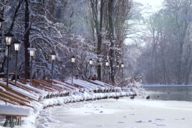
Snow-capped peaks, curling and roast chestnuts: Why is Munich so magnificent in winter?
It can't be emphasised enough: The winter really does envelope Munich in its pretty cape – at least for a few days – during the colder months. Those are the days when you look out the window in the morning and the old familiar view of the city has been replaced with an idyllic postcard scene, with snow-topped roofs and park benches, icicles hanging from the gutter and local monuments, and an altogether peaceful appearance – disturbed only by the sound of scratching on car windows.
And whenever lots of snow falls over the city and the nights are cold, Munich is transformed into a true winter wonderland. Its wide paths become cross-country skiing trails, and children are taken to nursery on a sled, while others make their first attempts to ski on the Olympiaberg (Olympic Mountain) and, of course, the Nymphenburger Kanal (Nymphenburg Canal) becomes the city’s key meeting place – let’s go curling!
News that the royal ice at the castle gates is finally thick enough always spreads through Munich like icy wildfire – and without the need for social media. The quiet carp highway in the west of the city is then transformed into a cheerful Brueghel painting over night, complete with mulled wine stands and curious bystanders. This can be quite an unsettling and puzzling scene for newcomers to the city: Where have all these people appeared from with their double-thick sheepskin jackets? Where can these groups of steam-breathing gentlemen usually be found, who are now discussing the game on their curling rink with such passion as if they came here every day?
Christmas market preferences are often passed down through the generations, just like a family’s favourite summer beer garden.
But that's just one loveable peculiarities about the locals – they lie in wait as the Nymphenburg Canal freezes over before pouncing on their frosty prey. And those who aren't too keen on curling can just bring along their skates instead. In any case, a typical Munich cellar or attic will always hold an ancient wooden curling stick, an old sled with a child’s seat, worn-out ice hockey sticks, tattered snow boots and a plastic mini bob from recent years.
While the locals embark on a mass pilgrimage to one particular canal, they set out in equally large numbers to various Christmas markets – everyone has a favourite. Christmas market preferences are often passed down through the generations, just like a family’s favourite summer beer garden. People tend to return to the place where they had their most impressive encounter with Santa Claus as a child. They take a look at the nativity figures and tuck into a bag of roasted chestnuts, which warm their hands in their coat pockets.
Munich’s beer gardens and Christmas markets have one thing in common: They seem to have their very own sense of time. After leaving the office for a quick glass of lunchtime punch at Sendlinger Tor (gate), you suddenly find yourself wandering around the Münchner Freiheit (square) late at night, carrying three expensive returnable mugs and wearing a scarf decorated with flecks of mustard. Oops!
The harbingers of Munich's winter are always the nearby peaks that slip into their bridal gown over night and refuse to take it off until May. The snow-capped mountains attract lots of people over the following months. They trudge through the underground stations and pedestrian zones with their skis and snowboards, spreading a touch of Olympic fever throughout the city. Everyone runs to the cobblers to tune their skis for the season ahead. This charming effect is particularly noticeable on the BOB (Bavarian Uplands Railway) and the express train to Garmisch. The platforms are a comically intermingled scene of city dwellers with their briefcases and mountain folk in their ski boots. Laptops meet avalanche shovels …
The little town of Kitzbühel is annexed as a temporary district and declared a playground for the people of Munich. All four-wheel drive cars from the city’s ring roads show what they’ve got as they manœuvre their way around the Stanglwirt (spa resort) and the car park near the Hornbahn (cable car). The little golden chamois on the cars clearly sets apart the locals who see winter as the nicest season of all. And there are quite a lot of them.
The harbingers of Munich’s winter are always the nearby peaks that slip into their bridal gown over night and refuse to take it off until May.
The most dreadful weather is traditionally during carnival in spring, which arguably highlights the locals’ ambivalent attitude towards this time of the year. They’re certainly more enthusiastic about other events, such as the Starkbierfest (Strong Beer Festival) a little later in the year. And just when you seriously consider emigrating to southern realms and curse the cold eastern winds that emanate from the Bayerischer Wald (Bavarian Forest), the first snowdrops start to bloom in the Englischer Garten (park). A short time later, winter leaves the city without a trace, and you're left with nothing but a bag of chestnut shells in your coat pocket.